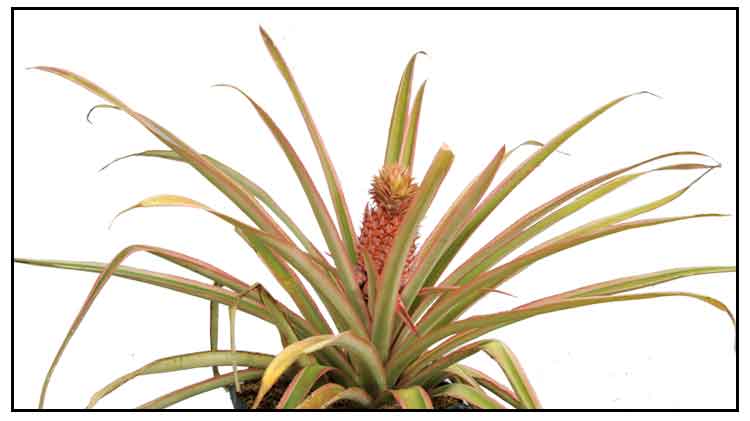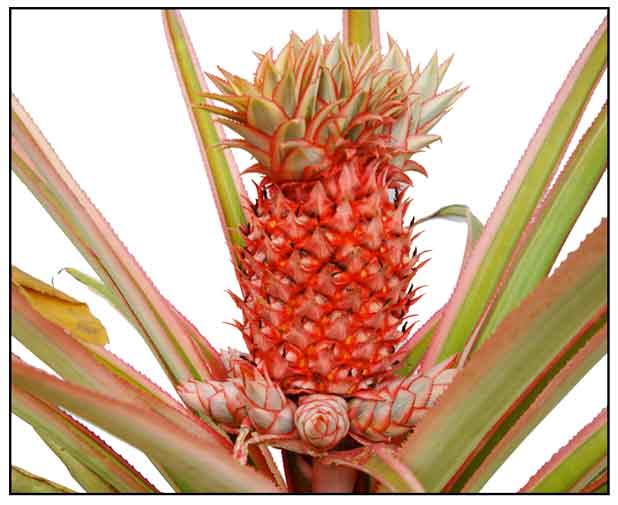 Botany Botany
- Similar to the pineapple (Ananas comosus) but the leaves have broad white stripes at the margins and the flowers are borne in showy, red heads.
- Red pineapple is an evergreen erect plant with small, violet-purple flowers that emerge between spiny, red or pink bracts on egg-shaped inflorescences. Inflorescences are followed by pink to scarlet, leafy topped, compound pineapple fruits. Leaves are linear, arching, solid dark green or variegated with white, pink, red or yellow, edged with sharp spines that curve up toward the leaf tips.
 Distribution Distribution
- Recently introduced to the Philippines.
- Native to Brazil.
- In Hawaii, used as border or hedge plant for its spiny leaves.
Parts
utilized
Leaves and roots.
Constituents
• Fruit and stems yield bromelain, a proteolytic enzyme used for treatment of trauma and inflammation.
• Study of various extracts yielded 9 compounds – campesterol, 3ß, 6ß-cholestanodiol, stigmasterol, sitosterol, 2-glyceryl ester of p-coumaric acid, a new compound 2-glyceryl ester of ferulic acid and 5,7,4'-trihydroxy-3,3'-5'-trimethoxy flavone, 3ß-O-glycopyranosyl sitosterol, 2-glyceryl ester of ferulic acid, and 2 new glycosides of ananasic acid.
• Purification of crude methanolic extract of leaves yielded four metabolites: 2-O-feruloyl glyceride, 2-O-p-coumaroyl glyceride, 5,7,4’-trihydroxy- 3,3’,5’-trimethoxy avone and 3-O-β-D-glucopyranosyl sitosterol. (see study below) (5)
Properties
• Antidiarrheal, abortifacient.
• Studies have suggested antioxidant and anti-inflammatory properties.
Uses
Edibility
• Red fruit is edible, although smaller and less fleshy than commercial pineapples.
Folkloric
• No reported folkloric medicinal use in the Philippines.
• Root decoction used for diarrhea.
• In Africa,used as abortifacient in a herbal concoction of Persea americana leaves, Curcuma longa rhizomes, Ananas bracteatus leaves, barks of Moringa oleifera and Leucana leucocephala.
• Decoction of leaves considered abortive in the Indian Ocean, Caribbean, and South America (Gueho, 1994) (6)

Studies
• Phytochemicals:
Study of various extracts yielded 9 compounds – campesterol, 3ß, 6ß-cholestanodiol, stigmasterol, sitosterol, 2-glyceryl ester of p-coumaric acid, a new compound 2-glyceryl ester of ferulic acid and 5,7,4'-trihydroxy-3,3'-5'-trimethoxy flavone, 3ß-O-glycopyranosyl sitosterol, 2-glyceryl ester of ferulic acid, and 2 new glycosides of ananasic acid.
• Bromelain / Anti-Inflammatory: Fruit and stems yield bromelain, a proteolytic enzyme used for treatment of trauma and inflammation. Studies suggest its anti-inflammatory effects is through its ability to decrease the migration of immune cells to the site of acute inflammation as well as decrease the secretion of inflammatory chemical agents such as interferon-gamma, interleukins and tumor necrosis factor.
• Bromelain / Dermatologic Benefits: In dermatology, oral bromelain has been shown to be effective in the treatment of Pityriasis lichenoides chronica. A dermatologic condition of unknown etiology, bromelain's effect is thought to be due to its anti-inflammatory, immunomodulatory and/or antiviral properties.
• Antioxidant / Leaves: Study evaluated 20 different extracts from six Brazilian Bromeliaceae species for antioxidant activity by assessment of their capacity to scavenge DPPH radicals. Among the leaf extracts, a crude methanolic extract of Ananas bracteatus showed significant antiradical activity. Purification of extract yielded four metabolites. (see constituents above) (5)
Availability
Wild-crafted. |

![]()

